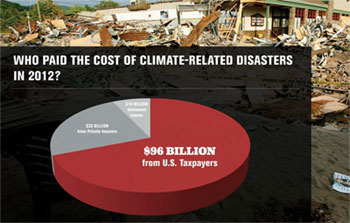Climate change could soon need its own line item in the US budget because unbelievably, the federal government spent more on disaster clean up last year than on transportation or education.
Taxpayers contributed $1100 each toward the $100 billion it cost to respond to extreme weather events last year, reports the Natural Resources Defense Council (NRDC) in their analysis.
"In fact, this single-ticket expense now tops the list of non-defense discretionary federal spending," notes Dan Lashof, co-author of the report and director of NRDC’s Climate and Clean Air Program.
This new "Climate Disruption Budget" equals one of every six dollars spent on non-defense discretionary programs, making it the largest such spending item, NRDC’s report shows.
Even more distressing is that the responsibility for paying for climate disruption has shifted to taxpayers and away from private insurers. Taxpayers are paying triple that of private insurers to help people recover from drought, storms, floods and wildfires.
The insurance industry estimates that 2012 was the second most expensive in U.S. history for climate-related disasters, with damages totaling more than $139 billion. But private insurers only covered about 25% of the costs. This shift in liabilities began in earnest following the $72 billion bill to the insurance industry in 2005 from Hurricane Katrina, and has continued to grow since.
The graph below shows that $33 billion came from private insurers, $10 billion was uninsured losses and $96 billion came from the federal government:

"The fact that private insurers are leaving the table sends an unmistakable signal. It tells us that climate change risks are increasing and their costs to our society are climbing," says Tom Steyer, the former hedge fund manager who has become very active advocating on climate change solutions.
Federal spending to deal with extreme weather made worse by climate change is far exceeding total spending aimed at solving the problem. In fact, it was eight times the Environmental Protection Agency’s total budget and eight times total spending on energy.
"Even as the budget to clean up climate disruptions hit a record high in 2012 and is expected to continue to grow, the budget for programs to fight climate disruption – such as environmental enforcement, energy efficiency, clean energy vehicle research and the ARPA-E – suffered cuts of more than $100 million under the "sequester," notes Dan Lashof.
Several months ago, NRDC released a ground-breaking proposal that many experts believe would address climate change: "Using the Clean Air Act to Sharply Reduce Carbon Pollution from Existing Power Plants, Creating Clean Energy Jobs, Improving Americans’ Health, and Curbing Climate Change."
NRDC’s plan would reduce carbon pollution from US power plants, which are responsible for 40% of our total carbon emissions. The EPA would use the Clean Air Act to set state-specific limits on carbon emissions. States and utilities would work together to meet the caps using a flexible system that encourages energy efficiency and use of a broad mix of cleaner energy sources.
The plan would cut carbon emissions 26% by 2020 at low cost with high environmental and health benefits, and would save utility customers on their electric bills.
Here’s NRDC’s report, "Who Pays for Climate Change?:
